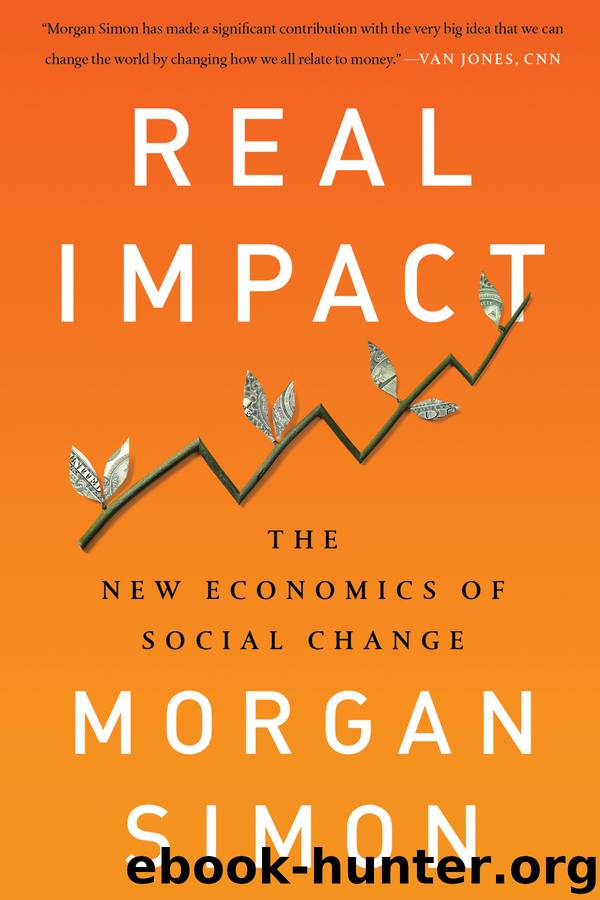Real Impact by Morgan Simon

Author:Morgan Simon
Language: eng
Format: epub
Publisher: PublicAffairs
Published: 2017-10-02T16:00:00+00:00
FAIRER THAN FAIR?
So how could one marry the best aspects of fair trade and direct trade—establish a consistent metric for a “living wage” price, incentivize quality production, and provide some collective resources to pay for community-level needs—all with transparency and accountability?
Emily Stone found herself in Belize in 2010 trying to solve this exact quandary. A native Bostonian, she had been sent on a fact-finding mission by the founder of Taza, a local company that was a pioneer in the “bean to bar” movement in chocolate. Taza’s founder had heard that cacao in Belize had previously been highly regarded, but that quality had declined over the past decade. Could an origin-focused chocolate company help revive the sector before families abandoned the crop—and hundreds of years of agricultural culture and tradition—for other, more profitable pursuits?4
Belize is a tiny country, with just over 360,000 people. It has one of the most diverse populations in Latin America: a mix of Q’eq’chi-and Mopan-speaking indigenous people; Garifuna-speaking people of African origin; and mestizo Spanish-speaking people, although the official language is English. Given its thriving tourism industry, average per capita annual income in Belize is estimated to be approximately $8,600, among the highest in Latin America—but the average farmer was getting by on just US$200 a month.5
In the south of Belize, cacao production was largely organized by the Toledo Cacao Growers Association—a fair trade association that farmers were slowly but surely abandoning. Visitors driving on the highway into Punta Gorda would pass by the half-constructed Museum of Cacao—a $500,000 project designed by the association, paid for with fair trade premiums, to grow tourism in the region. The museum was becoming overgrown by Belize’s lush vegetation and threatening to disappear into the forest before hosting a single visitor.
The farmers continued to sell cacao onto the world market. Despite functioning administratively as a cooperative, they processed their cacao individually—each farmer removing the pulp, drying the beans, and fermenting them. The fermenting process, when the character of the beans emerges, is, along with the plant’s origin, or terroir, the greatest determinant of flavor, and thus a critical part of the process. And like all things in life that require some skill and knowledge, some farmers were better at fermentation than others, leading to major quality variations. Given the uneven nature of fermentation across so many small farms, it was hard for the farmers to collectively maintain high quality and thus fetch the best price—so they continued along earning the historically low commodity price for cacao, plus an additional premium under the fair trade system.
Emily knew next to nothing about cacao at this point, but as a former member of Green Corps—a training program for organizers in the environmental movement—she knew how to connect with a community. She literally went door to door to the homes at over a hundred farms asking about cacao production and what it would take to build a more robust sector, preparing to “lead from behind” in response to community needs.
On one of those door-knocking expeditions she met Gabriel Pop, whose family had been farming cacao for generations.
Download
This site does not store any files on its server. We only index and link to content provided by other sites. Please contact the content providers to delete copyright contents if any and email us, we'll remove relevant links or contents immediately.
| Consulting | Entrepreneurship |
| Franchises | Home Based |
| Marketing | New Business Enterprises |
| Nonprofit Organizations & Charities |
Pioneering Portfolio Management by David F. Swensen(6226)
Man-made Catastrophes and Risk Information Concealment by Dmitry Chernov & Didier Sornette(5921)
Zero to One by Peter Thiel(5684)
The Motivation Myth by Jeff Haden(5155)
The Miracle Morning by Hal Elrod(4637)
Elon Musk by Ashlee Vance(4025)
The Art of Persistence: Stop Quitting, Ignore Shiny Objects and Climb Your Way to Success by Michal Stawicki(3623)
Unlabel: Selling You Without Selling Out by Marc Ecko(3587)
Delivering Happiness by Tony Hsieh(3363)
Urban Outlaw by Magnus Walker(3338)
Purple Cow by Seth Godin(3137)
Mastering Bitcoin: Programming the Open Blockchain by Andreas M. Antonopoulos(2980)
The Marketing Plan Handbook: Develop Big-Picture Marketing Plans for Pennies on the Dollar by Robert W. Bly(2975)
The Power of Broke by Daymond John(2896)
The Content Trap by Bharat Anand(2860)
Applied Empathy by Michael Ventura(2838)
The Airbnb Story by Leigh Gallagher(2797)
Keep Going by Austin Kleon(2696)
Radical Candor by Kim Scott(2667)
